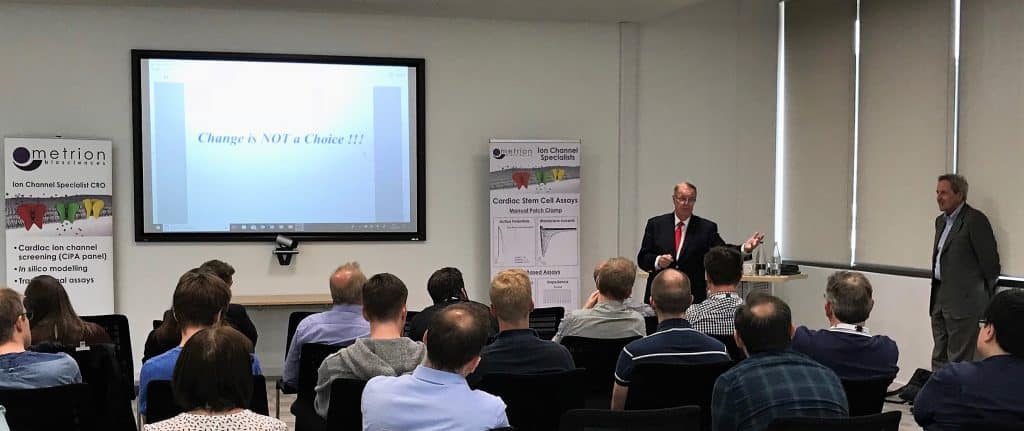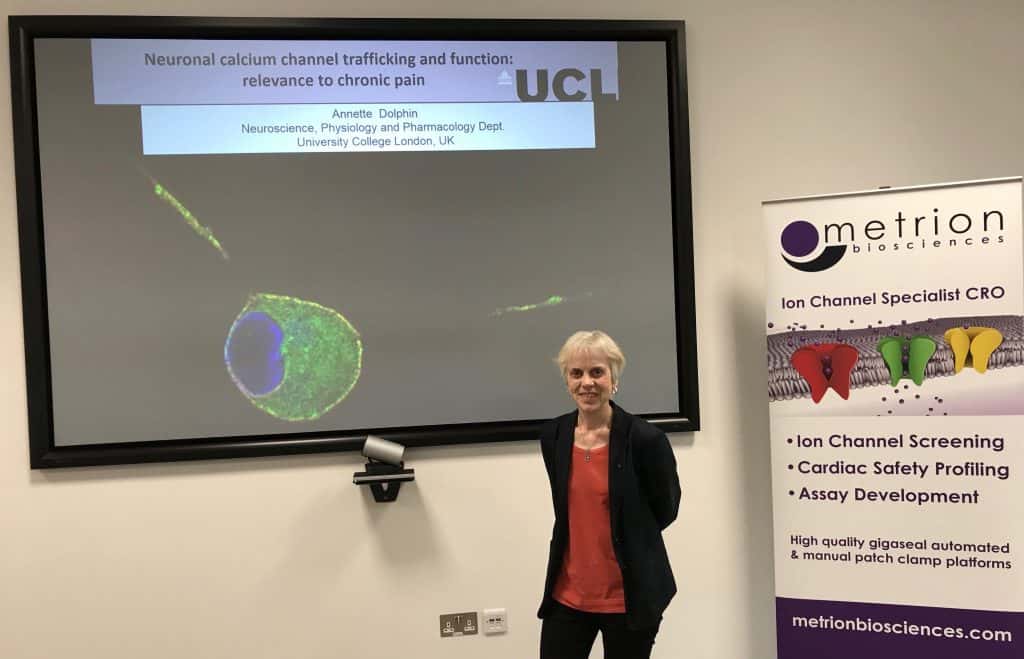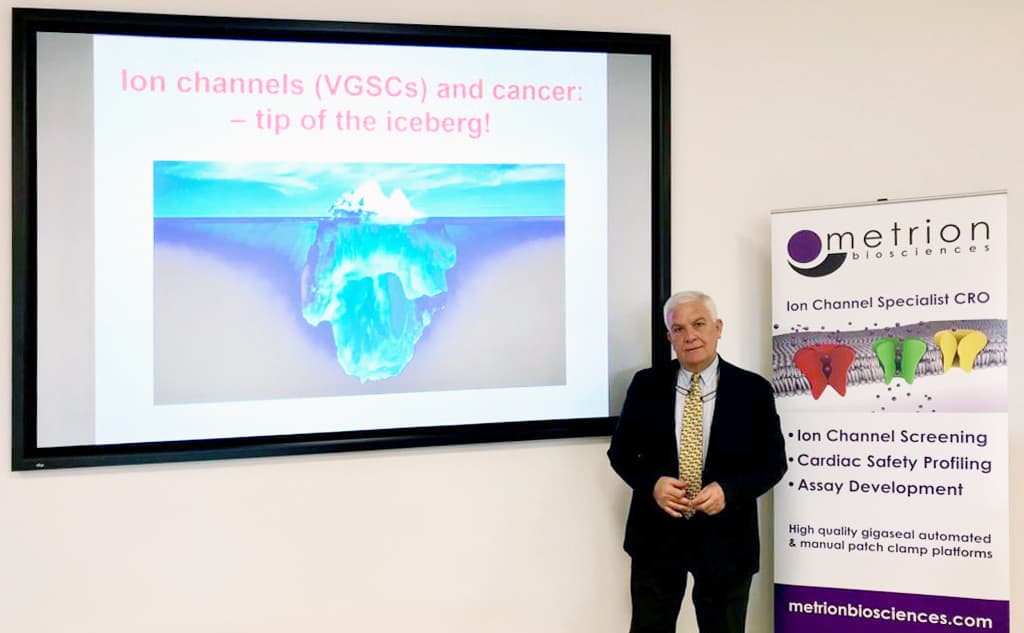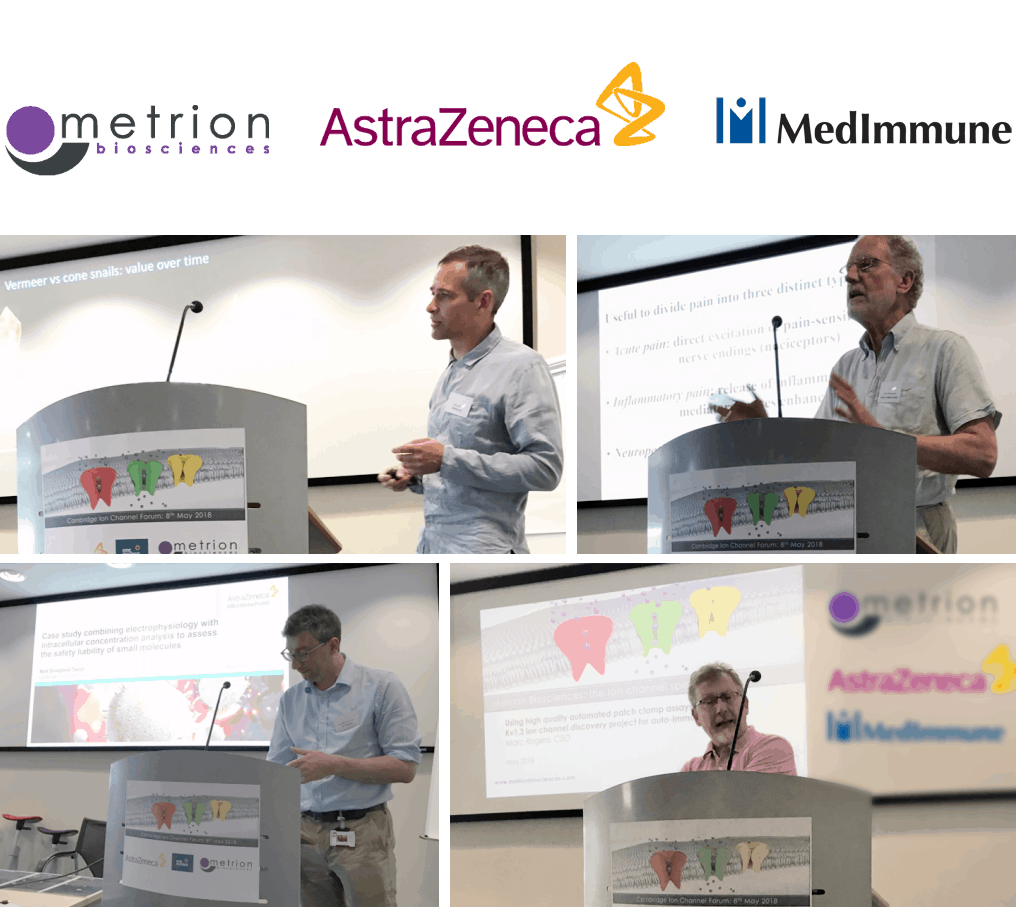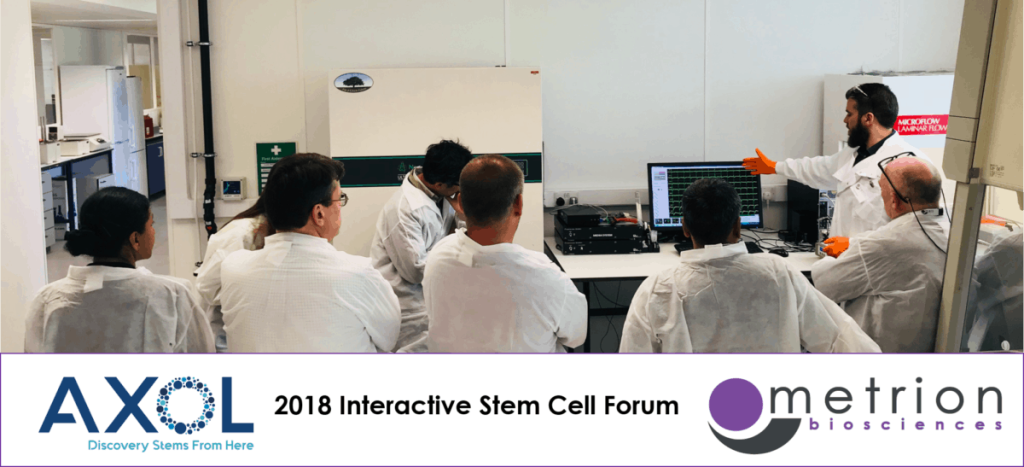Written by the Editor
Professor Gary Stephens gives his perspective on his research into calcium channel modulation, cannabinoid-derived anti-epileptic agents; plus biologics and SUMOylation in the field of ion channel modulation.

Calcium channels and synaptic transmission are major components of your research career. What inspired you to focus on these areas and what is the basis of your continued interest?
As a post-doctoral worker with Wyeth Research I was bitten by the ion channel electrophysiology bug. Back then (in the early 90’s) I initially worked on cloned potassium channels which were then not widely accessible, but were made available to Wyeth via an academic collaboration. I wanted to move towards ion channel modulation and subsequently became the first post-doctoral researcher in Annette Dolphin’s group (then based at the Royal Free Hospital site of University College London’s Pharmacology Department) to perform electrophysiological work on cloned channels.
It was this initial work on cloned channels and subsequent work on G protein modulation that inspired my future focus. This work largely confirmed Annette’s previous data in native neurons, but added a molecular aspect with great input from researchers such as Karen Page and Nick Berrow, who made mutant and chimeric channels for us to test using patch clamp electrophysiology.
Whilst looking to carve out a niche for myself, I approached Brian Robertson at Imperial College (whom I knew from my studies at Wyeth Research) to take the in vitro cloned calcium channel work into an ex vivo brain slice preparation. Brian’s lab was working on potassium channel function in the cerebellum, including pioneering work on presynaptic function performed by Andy Southan (also an ex-Wyeth scientist and now COO at Metrion).
My input was to investigate the role of calcium channels in synaptic transmission in the cerebellum and I was fortunate enough to secure a Wellcome Trust project grant to make me an independent researcher in Brian’s laboratory. I still find inspiration in using electrophysiology to investigate ion channel function, the fact that such experiments are not straightforward and require dedication makes the data collected somehow very meaningful for me.
The treatment of childhood epilepsy with cannabis oil received a substantial amount of media interest in June 2018 and has since been the source of significant debate regarding the medicinal properties of products derived from cannabis and their ethical use. The recent FDA approval of GW Pharmaceuticals’ Epidiolex (an oral formulation of cannabidiol) for the treatment of Lennox-Gastaut syndrome and Dravet syndrome clearly demonstrates the importance of your body of research with Professor Ben Whalley into cannabinoid-derived anti-epileptic agents. As a researcher who has been closely involved in this field for some time, what developments do you envisage in the short and longer term for cannabinoid-derived therapies?
It is probably fair to say that I became involved in cannabis research rather as a side-line when I joined the University of Reading in 2005, being one of three members of the nascent pharmacology group in the then new School of Pharmacy. I joined Reading following a Wellcome Trust Pain Consortium-sponsored Lecturer position at University College London and Ben Whalley, a fellow University of London electrophysiology émigré, had also just started at Reading.
Ben and I were looking to collaborate and set up an electrophysiology group at Reading and Ben had research experience in cannabinoids and their role in epilepsy. Together with Claire Williams, an expert in behavioural models, we formed a team with industrial funding from GW Pharmaceuticals. I was interested because cannabinoids activate G protein-coupled receptors, which reduce calcium currents and inhibit synaptic transmission.
However, we subsequently discovered that the most active cannabinoid in our experiments, namely cannabidiol (CBD), had no meaningful affinity at CB1 receptors and so must have an alternative mechanism of action. It is also fair to say that we are still looking for CBD’s mechanism, which may involve different molecular targets to ultimately modulate the body’s endocannabinoid system. There is also some evidence that CBD may modulate CB1 at alternative ‘allosteric’ sites.
What is clear is that the approval of CBD as the drug Epidiolex heralds a step-change in the way cannabis-derived medications may be used now and are perceived in the future. It is important to point out that Epidiolex is the first non-THC cannabis-derived medication to be approved. It has been somewhat of a holy grail for the pharmaceutical industry to divorce centuries of anecdotal evidence of potential medicinal benefit of cannabis from the unwanted euphoric effects associated with recreational cannabis use.
The seemingly obvious solution is to develop investigate alternative cannabinoids to THC, which is widely regarded as the only psychoactive component in cannabis. This appears to be borne out by the fact that extracts from plants directed down the route to produce more CBD, the other major cannabinoid, had clear anti-epileptic effects in the models we used at the University of Reading.
The Home Secretary, Sajid Javid recently intervened to grant special licence for a patient with severe childhood epilepsy, Billy Caldwell, to use cannabis oil, which is classified as a Schedule 1 drug i.e of no medicinal value. This decision has prompted the UK government to ask the ACMD to reconsider the classification of cannabis-based medicines. What is clearer is that the Medicines and Healthcare products Regulatory Agency now consider CBD, at least, to be a medicine.
Undoubtedly, these moves are likely to propel the investigations of cannabis-based therapies forward and whilst the question of medicinal use has been obfuscated by arguments surrounding recreational use, there are a large number of clinical trials currently underway, in particular for cancers.
A question is, should we forego medicines that contain THC in favour of CBD (and potentially other non-THC cannabinoids)? Of course, placebo-controlled, large scale human trials remain the desire and only this type of evidence will overcome the stigma still associated with medicinal use of cannabis.
Biologics-based approaches present us with a number of routes to novel therapeutics, although ion channels are a challenging target class due to the limited availability of externally accessible epitopes. Can you tell us more about your programme investigating the modulation of calcium channels by intracellular antibodies ‘intrabodies’ and the therapeutic area(s) this research may benefit?
The project on calcium channels antibodies was sponsored by UCB Pharma and continues my productive collaborative relationship with them. We aimed to raise antibodies against regions of the Cav2.2 channel that we previously implicated to be involved in synaptic transmission and G protein modulation (Bucci et al., 2011 ). This project successfully generated a number of antigen-binding (Fab) fragments, but ultimately these lacked sufficient activity for further development in our assays.
However, this project kick-started our interest in producing antibodies in different species and we have recently raised antibodies in llamas and cows, as well as in sheep at the University of Reading Centre for Dairy Research (CEDAR). In particular, the use of llamas to produce specialised single variable heavy chain antibodies is another area of research that has proved fascinating. Llama antibodies have potential to be used in development of therapeutics and also in structural studies, and this has started to generate significant pharmaceutical industry and academic interest in working with the University of Reading to produce specialised camelid antibodies.
You have also been involved in research focused upon Small Ubiquitin-like Modifier (SUMO) proteins. In terms of publications, SUMOylation has been characterised in both cardiac and brain tissues. Have we reached a point where we may start to exploit this knowledge in terms of novel therapies?
We have been looking at the effects of SUMO on Cav2.2 function and are currently looking at effects in native neurons. We and others believe that SUMOylation is an extremely important post-translational modification, akin to processes such as phosphorylation, and may act similarly as a molecular switch to regulate biological processes.
Whilst SUMOylation was previously shown widely to affect nuclear processes, it has become clear that membrane ion channels and receptors are also key SUMO targets. This has relevance for synaptic function in the CNS, but also in the cardiac system.
Recent work has indeed detailed the development of small molecules that target SUMO pathway enzymes and suggest potential for therapeutic advances, for example, with significant interest as anti-cancer drugs. Here, molecules that inhibit key sentrin-specific protease (SENP) and SUMO ligase isoforms are in clinical development.
It will be of interest to follow this area and see if opportunities to treat conditions such as brain ischemia, neurodegenerative diseases and/or cardiovascular disease also arise. For brain diseases, Cav2.2 calcium channels are key players in presynaptic transmitter release and so are likely to be viable targets.
What are your future research plans?
Our recent work has identified a novel protein called CACHD1 that modulates the function of Cav3 (T-type) calcium channels and this is an area that I am keen to expand. This work is currently in press and was performed in collaboration with Eddy Stevens (now Head of Drug Discovery at Metrion) and his former colleagues at Pfizer, and with Manoj Patel (University of Virginia, USA) and Graeme Cottrell at Reading.
This work was begun by an industrial PhD CASE award between University of Reading and Pfizer to Camille Soubrane. I will chair a session “Targeting calcium ion channels in disease” where I will talk on this new work with CACHD1 at the forthcoming Pharmacology 2018 meeting at the Queen Elizabeth Centre, London 18th – 20th December 2018.
In addition, I am keen to extend the areas of work detailed above. Whilst the emphasis remains on calcium channel modulation, we will present work on THC binding and activation of CB1 receptors at Pharmacology 2018 and I am currently hosting Erik Aostri, a PhD student from the University of the Basque Country, who is investigating interactions between CBD and serotonin receptors in the hippocampus.
I have a PhD student (with my colleague Angela Bithell) who is investigating the role of NMDA auto-antibodies in epilepsy, this project is sponsored by UCB Pharma. I also have a PhD student (with my colleague Mark Dallas) who is investigating effects of the Alzheimer disease-associated amyloid beta protein on calcium channels, this project is sponsored by the Alzheimer’s Association.
We have focused on potential modulation of amyloid beta actions by the gasotransmitter carbon monoxide; Mark Dallas and I have submitted a proposal to organize a symposium on this topic at the forthcoming Life Sciences 2019: Post-Translational Modifications and Cell Signalling, East Midlands Conference Centre, Nottingham, United Kingdom 17th – 18th March 2019.
What made you choose to stay in academia rather than going into industry?
Perhaps the major reason for pursuing an academic career is my interest in teaching. It is of interest that teaching excellence is increasingly recognised as key to a university’s success and critical to progression alongside research achievements. Teaching is something that I enjoy and I have acted as School of Pharmacy Director of Teaching and Learning in the past, as well setting up an MSc by Research programme more recently.
Alongside this, my first post-doctoral position was in industry at Wyeth Research UK and this position opened my eyes to the rewards, but also the reality, of working in industry. I was employed as a two-year Wyeth Post-Doctoral Fellow and was fortunate enough to be offered a one-year extension. However, one month into this extension it was announced that the research side of Wyeth UK was to close and only selected researchers were to be relocated to Princeton, New Jersey.
I was fortunate enough to be able to bring forward plans to work with Annette Dolphin at UCL, but this did highlight the sometimes precarious nature of industry-based science. Several of my peers have continued to forge great careers in industry, but often this involves fairly short notice changes in jobs and this is not a model that I have pursued. This is likely accentuated by the fact that my area is in neuroscience and the majority of major industrial players in this field have largely vacated the UK in the last decade or so.
I do enjoy the freedom to research that academia can offer, but think this is sometimes over-emphasised. In fact, academia-industry partnerships are now becoming far more widespread and not the “third-stream” in relation to project grant and charity funding that they were once considered. As above, I have received significant industrial funding from UCB, Pfizer and GW Pharmaceuticals. Such projects have offered academic freedom to pursue research projects of clear industrial importance and have taught an appreciation to focus on key questions.
Do you feel that pharmaceutical companies do enough to engage with academics and embrace their findings?
As above, I feel that this area has improved greatly over the last decade or so. Whilst industry is often keen to develop products in-house, the increasing realisation that specialised academic input can be key to success has led to significant increases in industry-academia partnerships, such as those that I have entered into. There is also much more government/RCUK funding initiatives in this area that reflect and drive this increased effort.
How do you feel that the landscape of academia has changed in recent years?
I think that the academic landscape has changed considerably over the last ten years. The biggest drivers here have been increased proportion of students entering higher education, the rise in fees and an associated increase in professionalism around running universities as what are now effectively big businesses. University are often run by Vice Chancellors with business/management experience rather than former academics rising through the ranks.
In my role as head of the Pharmacology Group within the Reading School of Pharmacy, I now perform Performance and Development Reviews, and staff within academia are expected to contribute to the regular submissions for the Research Excellence Framework and the newer Teaching Excellence Framework. In these respects, the perceived differences between academia and industry are further narrowing and many would argue that good practices long adopted in the industry sector are now becoming routine in academia.
Why do think ion channels have been a difficult drug target class for the pharmaceutical industry?
This is a deceptively difficult question! A simple answer is that this is likely due to the ubiquity of ion channels. For example, there are only ten known voltage-dependent calcium channel subtypes and these are grouped into three families which each perform similar functions, often in different parts of the body. Drug targeting still largely relies on selectivity and this has proved difficult.
Some therapeutic benefits have been obtained by using selective routes of drug administration. For calcium channels, ziconotide applied via an intrathecal route to treat pain is an example. Cardiac drugs that target Cav1 L-type channels are useful, but still lack good selectivity. There may also be utility in targeting accessory subunits such as calcium channel alpha-2-beta subunits by gabapentinoids.
Development of ion channel subunit selective small molecules continues to be a major aim for the pharmaceutical industry. For example, in the potentially lucrative field of pain research, it is hoped that a promising quantity of preclinical data can eventually be translated into the clinic for targets such as Cav2.2, Cav3.2 and, in particular, Nav1.7 in pain and newer targets such as TRP channels and acid-sensitive ion channels. Metrion’s Eddy Stevens and I acted as Guest Editors on a recent British Journal of Pharmacology themed issue “Recent advances in targeting ion channels to treat chronic pain” where we discuss this further.
Acknowledgements
Gary gave the first presentation in Metrion Biosciences External Speaker Series in November 2016, his presentation can be found via: this link.
The Metrion Biosciences’ External Speaker Series was established as a forum for leading academic researchers to present their latest research to our staff and staff from other companies in the Cambridge area. The Metrion team welcomes suggestions for future speakers and topics via: this link.
You can also sign up for Metrion Biosciences updates via: this link. You can alter your preferences or unsubscribe at any time.


